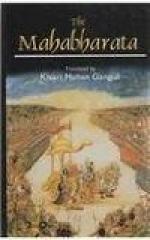SECTION XXXVI
“Brahma said, ’That which is unmanifest, which is indistinct, all-pervading, everlasting, immutable, should be known to become the city (or mansion) of nine portals, possessed of three qualities, and consisting of five ingredients. Encompassed by eleven including Mind which distinguishes (objects), and having Understanding for the ruler, this is an aggregate of eleven.[104] The three ducts that are in it support it constantly. These are the three Nadis. They run continually, and have the three qualities for their essence: Darkness, Passion, and Goodness. These are called the (three) qualities. These are coupled with one another. They exist, depending on one another. They take refuge in one another, and follow one another. They are also joined with one another. The five (principal) elements are characterised by (these) three qualities. Goodness is the match of Darkness. Of Goodness the match is Passion. Goodness is also the match of Passion, and of Goodness the match is Darkness. There where Darkness is restrained, Passion is seen to flow. There where Passion is restrained, Goodness is seen to flow. Darkness should be known to have the night (or obscurity) for its essence. It has three characteristics, and is (otherwise) called Delusion. It has unrighteousness (or sin) also for its indication, and it is always present in all sinful acts. This is the nature of Darkness and it appears also as confined with others. Passion is said to have activity for its essence. It is the cause of successive acts. When it prevails, its indication, among all beings, is production. Splendour, lightness, and faith,—these are the form, that is light, of Goodness among all creatures, as regarded by all good men. The true nature of their characteristics will now be declared




